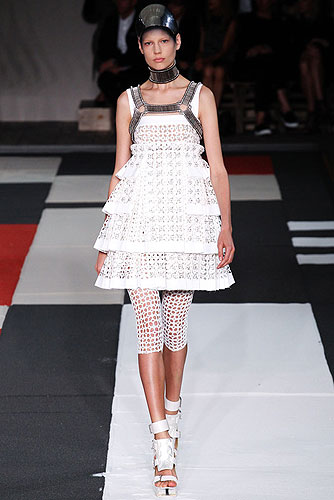
































It was always in the evening looks where a McQueen collection would swing into a fetishistic overdrive of technique.
www.alexandermcqueen.comParisFashion WeekFashion Brand
It was always in the evening looks where a McQueen collection would swing into a fetishistic overdrive of technique.
"I didn't want it to feel too referenced to a period or a theme," Sarah Burton said about the magical collection she showed for Alexander McQueen tonight. True, there was nothing so specific as to anchor the clothes we saw to any one time or place, but the associations flew thick and fast: the golden helmets, harnesses, and armlets of Amazons; ostrich-feathered Zulus; the intricate beaded outfits of tribal priestesses; the kilt-over-trouser combo of the Celtic warrior; the graphic geometries of Mondrian, or Picasso in his African period.…
Lee McQueen always insisted that National Geographic was his first port of call, and that magazine's ethnic grab bag pulsated in Burton's collection, in graphic checkerboard beading, in flurries of ostrich feathers, in crocodile breastplates. It added up to a primal image of strength and empowerment. Burton's twins are eight months old now, and she's ready to get back in the game; there was an overwhelming sense of reconnection in her collection. "Saying something new, saying something personal," was the way she put it. Much of that jelled with things we've been hearing elsewhere. The harness tops and leggings under flaring skirts were timely. Even more so was the notion of female tribalism that has reverberated throughout the season. What differentiated the McQueen take on these ideas was the mind-boggling craftsmanship. Checks? Such a simple little word, until those checks were configured in beads and feathers hand-worked with minute precision.
It was always in the evening looks where a McQueen collection would swing into a fetishistic overdrive of technique. Here? "I didn't want to do 'big' gowns," said Burton. "I wanted energy without froth." So there was a dress that looked like a beautiful lattice of recycled plastic, and another with rings of red feathers reaching skyward, simultaneously a Capucci couture quote and an evocation of tribal dancers. The show notes referenced "found objects," which made it easy to imagine these clothes becoming the subject of cargo cults in the distant future, some tribe-to-come wondering why—and, maybe more important, how.